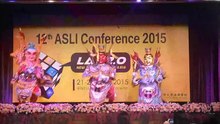San Taizi Techno Dance

The San Taizi techno dance ( Chinese 電 音 三 太子 , Pinyin Diànyīn sāntàizi ) is a folk dance style in Taiwan that arose from a connection between traditional Taiwanese folk religion and modern western influences. The name comes from the Buddhist-Daoist deity Nezha , who is popularly known as the "Third Prince" (Chinese: San Taizi ).
Emergence
There are different explanations for the origin of the dance. One theory suggests that the dance originated in Beigang in Yunlin County , other theories speculate that the place of origin of the dance is Puzi in Chiayi County . The dance was initially performed by lay troops from individual local temples, but more recently also by professional troops.
The origin of the dance lies in the tradition of having the main deities accompanied by a retinue of lower deities or officers in Daoist processions. These divine bodyguard figures (大仙 尪 仔) are shown by specially trained actors in colorful, often larger than life costumes and masks.
Since movement and dance in the heavy costumes require great agility, strength and endurance, the role of the actor usually falls to young men. It is said that it was young men who brought their favorite music from their modern everyday life - disco and techno music - and danced alternately to traditional and techno rhythms during the temple processions.
This new mix found such a liking with the audience and also appealed to a younger audience, so that the style soon spread. The main role is played by the figure of Nezha San Taizi , from whom the dance takes its name. In addition to the music, other modern elements are occasionally added to the dance, such as self-created choreographies and modern accessories on the costumes, such as B. Sunglasses or white gloves.
music
The San Taizi techno dance is danced to modern techno rhythms, both to the procession participants' own compositions and to popular disco songs, such as B. the Korean dance ensemble. The Taike dance , however, is of particular importance, as it is hardly missing in any techno procession and is part of the standard repertoire of all performances.
meaning
The amalgamation of popular religious tradition with modern pop culture and taike dance resulted in a unique style found only in Taiwan, which has recently become an expression of modern Taiwanese identity. San Taizi techno dance, and in particular the taike dance, are popular today at many public events, both religious and non-religious. In the meantime, the dance has even become a flagship of Taiwan at international events such as the World Games 2009 , the Deaflympics 2009, the Expo 2010 in Shanghai, the international flower fair 2010 in Taipei .
Individual evidence
Web links
- Techno Nezha Great God General , website of the photographer Rich J. Matheson
- Taike dance at a temple festival
literature
- Tzheng Chi Hsiung, Tsai Chin Chia: "Techno Dancing Gods" - Comicized Deity Images as Expressions of Taiwanese Cultural Identity , in: Nault, Derrick M. et al .: Experiencing Globalization: Religion in Contemporary Contexts , Anthem Press, London 2014, p 181-192.

